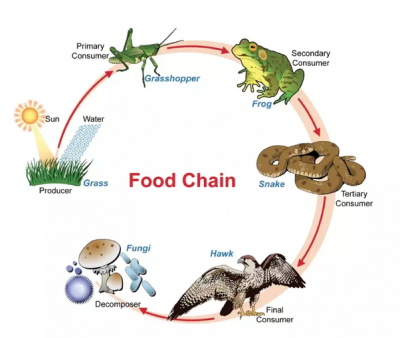
No living thing can survive without food. A food chain shows how a specific set of plants and animals are linked together by who eats what. Each arrow in a food chain means “is eaten by”. The chain ends when it reaches an animal that has no natural predators. If one link is removed, the chain will break.
Producer
Plants are the first level in the food chain or food webs and are known as primary producers. They make all the food and energy that is found in an ecosystem. Without plants people or other animals could not survive because we would not have the food or energy that we need. Plants and vegetable make their own food and energy through a process called photosynthesis.
Plants make their own food by using sunlight, carbon dioxide from the air, and water from the soil and converting it in the form of glucose/sugar.
In photosynthesis plants also produce oxygen which is left in the air for us to use.
In order to undergo photosynthesis plants need some helpers. One of the helpers they need is a green substance in their leaves called chlorophyll. Plants use this green substance to catch the energy they need from the sunlight.
Primary consumer
Primary consumers are herbivores, feeding on plants. Caterpillars, insects, grasshoppers, termites and hummingbirds are all examples of primary consumers because they only eat autotrophs (plants). There are certain primary consumers that are called specialists because they only eat one type of producers an example of this would be the koala because it feeds only on eucalyptus leaves. Primary consumers who feed on many kinds of plants are called generalists.
Secondary consumer
Animals that eat herbivores are secondary consumers. They can be carnivores, which eat other animals, or omnivores, which eat animals and plants. A robin is a secondary consumer.
Secondary consumers come in all shapes, sizes, and exist in practically every habitat on earth. Icy tundra’s, arid savannahs, and artic waters are just some of the extreme environments secondary consumers live in. Whether on land or in water, the one thing they have in common is the type of food they eat—primary consumers.
Tertiary consumer
Tertiary consumers eat primary and secondary consumers as their main source of food. These organisms are sometimes referred to as apex predators as they are normally at the top of food chains, feeding on both primary and secondary consumers.
Tertiary consumers can be carnivores or omnivores. Their diet can comprise only meat or include plants as well. A hawk, for example, can feed on primary consumers such as birds, as well as secondary consumers such as snakes.
Picture Credit : Google

